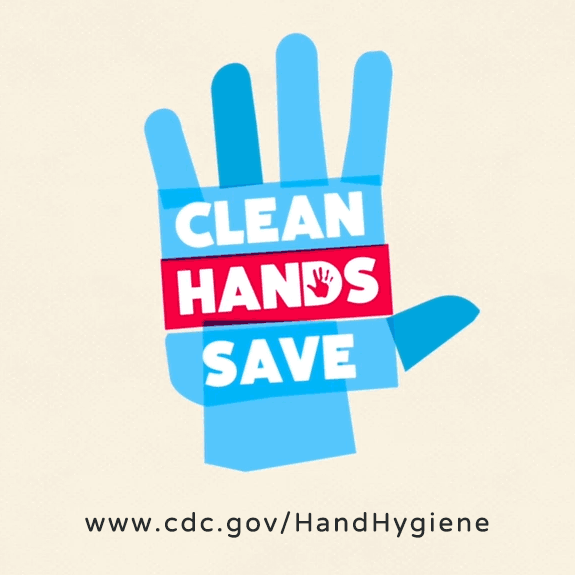Key points
- Patients in healthcare settings are at risk of getting infections while receiving treatment for other conditions.
- Cleaning your hands can prevent the spread of germs, including those that are resistant to antibiotics, and protects healthcare personnel and patients.
- Patients and their loved ones can play a role in asking and reminding healthcare personnel to clean their hands.

The facts
Your hands can spread germs.
- Hands have good germs that your body needs to stay healthy. Hands can also have bad germs on them that make you sick.
Alcohol-based hand sanitizer kills most of the bad germs that make you sick.
- Alcohol-based hand sanitizers kill the good and bad germs, but the good germs quickly come back on your hands.
Alcohol-based hand sanitizer does not create antimicrobial-resistant germs.
- Alcohol-based hand sanitizers kill germs quickly and in a different way than antibiotics.
- Using alcohol-based hand sanitizers to clean your hands does not cause antimicrobial resistance.
Steps to take
When patients and visitors should clean their hands
- Before preparing or eating food.
- Before touching your eyes, nose, or mouth.
- Before and after changing wound dressings or bandages.
- After using the restroom.
- After blowing your nose, coughing, or sneezing.
- After touching hospital surfaces such as bed rails, bedside tables, doorknobs, remote controls, or the phone.
How to clean hands
With an alcohol-based hand sanitizer:
- Put product on hands and rub hands together.
- Cover all surfaces until hands feel dry.
- This should take around 20 seconds.
With soap and water:
- Wet your hands with warm water. Use liquid soap if possible. Apply a nickel- or quarter-sized amount of soap to your hands.
- Rub your hands together until the soap forms a lather and then rub all over the top of your hands, in between your fingers and the area around and under the fingernails.
- Continue rubbing your hands for at least 15 seconds. Need a timer? Imagine singing the "Happy Birthday" song twice.
- Rinse your hands well under running water.
- Dry your hands using a paper towel if possible. Then use your paper towel to turn off the faucet and to open the door if needed.
Clean Hands Count Campaign Materials
Ask your healthcare provider to clean their hands
- Wearing gloves alone is not enough for your healthcare provider to prevent the spread of infection.
- Ask questions like:
- "Before you start the exam, would you mind cleaning your hands again?"
- "Would it be alright if you cleaned your hands before changing my bandages?"
- "I didn't see you clean your hands when you came in, would you mind cleaning them again before you examine me?"
- "I'm worried about germs spreading in the hospital. Will you please clean your hands once more before you start my treatment?"
- "Before you start the exam, would you mind cleaning your hands again?"
Speak up for clean hands in healthcare settings
- Clean your own hands and ask those around you to do the same.
- Don't be afraid to use your voice: it's okay to ask your healthcare provider to clean their hands.
- Ask your loved ones and visitors to clean their hands, too, using questions like:
- "I saw you clean your hands when you arrived some time ago, but would you mind cleaning them again?"
- "I saw you clean your hands when you arrived some time ago, but would you mind cleaning them again?"
Frequently asked questions
Is there such a thing as too clean?
- Germs are everywhere. They are within and on our bodies and on every surface you touch. But not all germs are bad. We need some of these germs to keep us healthy and our immune system strong.
- Your hands have good germs on them that your body needs to stay healthy. These germs live under the deeper layers of the skin.
- Your hands can also have bad germs on them that make you sick. These germs live on the surface and are easily killed/wiped away by the alcohol-based hand sanitizer.
- Using an alcohol-based hand sanitizer is the preferred way for to keep your hands clean.
- Alcohol-based hand sanitizers kill the good and bad germs, but the good germs quickly come back on your hands.
Washing with soap and water: 15 versus 20 seconds
- Wash your hands for more than 15 seconds, not exactly 15 seconds.
- The time it takes is less important than making sure you clean all areas of your hands.
- Alcohol-based hand sanitizers are the preferred way to clean your hands in healthcare facilities.
Which one? Soap and water versus alcohol-based hand sanitizer
An alcohol-based hand sanitizer is the preferred method for cleaning your hands when they are not visibly dirty because it:
- Is more effective at killing potentially deadly germs on hands than soap.
- Is easier to use during the course of care, especially:
- when moving from soiled to clean activities with the same patient or resident.
- when moving between patients or residents in shared rooms or common areas.
- when moving from soiled to clean activities with the same patient or resident.
- Improves skin condition with less irritation and dryness than soap and water.
Guidelines for Hand Hygiene in Healthcare Settings Published 2002
Core Infection Prevention and Control Practices for Safe Healthcare Delivery in All Settings
What CDC is doing
CDC's Clean Hands Count campaign offers posters, factsheets, and brochures for healthcare providers and patients.
Keep reading: Clean Hands Count materials
Resources
Healthcare personnel
When and how to practice hand hygiene. Learn more.
New Training and Education Resources available for Healthcare Professionals.
Hand Hygiene in Healthcare Settings Video Series link: Education Courses | Hand Hygiene | CDC
